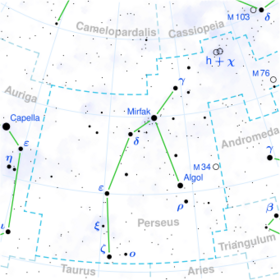Astronomy:Pi Persei
| Observation data Equinox J2000.0]] (ICRS) | |
|---|---|
| Constellation | Perseus |
| Right ascension | 02h 58m 45.66858s[1] |
| Declination | +39° 39′ 45.8212″[1] |
| Apparent magnitude (V) | 4.70[2] |
| Characteristics | |
| Spectral type | A2Vn[3] |
| U−B color index | +0.12[2] |
| B−V color index | +0.06[2] |
| Astrometry | |
| Radial velocity (Rv) | +14.2[4] km/s |
| Proper motion (μ) | RA: +26.224[1] mas/yr Dec.: −41.899[1] mas/yr |
| Parallax (π) | 10.7797 ± 0.2794[1] mas |
| Distance | 303 ± 8 ly (93 ± 2 pc) |
| Absolute magnitude (MV) | −0.21[5] |
| Details | |
| Mass | 2.07[6] M☉ |
| Radius | 4.8[7] R☉ |
| Luminosity | 170[8] L☉ |
| Surface gravity (log g) | 3.53[6] cgs |
| Temperature | 9,290[8] K |
| Rotational velocity (v sin i) | 186[8] km/s |
| Age | 272[6] Myr |
| Other designations | |
| Database references | |
| SIMBAD | data |
π Persei, Latinized as Pi Persei, is a single[11] star in the northern constellation of Perseus. It has the traditional name Gorgonea Secunda /ɡɔːrɡəˈniːə sɪˈkʌndə/, the second of three Gorgons in the mythology of the hero Perseus.[12] This star has a white hue and is faintly visible to the naked eye with an apparent visual magnitude of +4.7.[2] It is located at a distance of approximately 303 light years from the Sun based on parallax,[1] and is moving further away with a radial velocity of +14 km/s.[4]
This object is an A-type main-sequence star with a stellar classification of A2Vn,[3] where the 'n' suffix indicates broad (nebulous) lines due to rapid rotation. It is spinning with a projected rotational velocity of 186 km/s,[8] which is creating an equatorial bulge that is 6% wider than the polar radius.[13] The star is 272[6] million years old with double the mass of the Sun.[6] It has 4.8[7] times the Sun's radius and is radiating 170[8] times the luminosity of the Sun from its photosphere at an effective temperature of 9,290 K.[8]
References
- ↑ 1.0 1.1 1.2 1.3 1.4 1.5 Brown, A. G. A. (August 2018). "Gaia Data Release 2: Summary of the contents and survey properties". Astronomy & Astrophysics 616: A1. doi:10.1051/0004-6361/201833051. Bibcode: 2018A&A...616A...1G. Gaia DR2 record for this source at VizieR.
- ↑ 2.0 2.1 2.2 2.3 Ducati, J. R. (2002). "VizieR Online Data Catalog: Catalogue of Stellar Photometry in Johnson's 11-color system". CDS/ADC Collection of Electronic Catalogues 2237. Bibcode: 2002yCat.2237....0D.
- ↑ 3.0 3.1 Abt, Helmut A.; Morrell, Nidia I. (1995). "The Relation between Rotational Velocities and Spectral Peculiarities among A-Type Stars". Astrophysical Journal Supplement 99: 135. doi:10.1086/192182. Bibcode: 1995ApJS...99..135A.
- ↑ 4.0 4.1 Wilson, R. E. (1953). "General Catalogue of Stellar Radial Velocities". Carnegie Institute Washington D.C. Publication (Carnegie Institution for Science). ISBN 9780598216885. Bibcode: 1953GCRV..C......0W.
- ↑ Anderson, E.; Francis, Ch. (2012). "XHIP: An extended hipparcos compilation". Astronomy Letters 38 (5): 331. doi:10.1134/S1063773712050015. Bibcode: 2012AstL...38..331A. Vizier catalog entry
- ↑ 6.0 6.1 6.2 6.3 6.4 David, Trevor J.; Hillenbrand, Lynne A. (2015). "The Ages of Early-Type Stars: Strömgren Photometric Methods Calibrated, Validated, Tested, and Applied to Hosts and Prospective Hosts of Directly Imaged Exoplanets". The Astrophysical Journal 804 (2): 146. doi:10.1088/0004-637X/804/2/146. Bibcode: 2015ApJ...804..146D. Vizier catalog entry
- ↑ 7.0 7.1 Allende Prieto, C.; Lambert, D. L. (1999). "Fundamental parameters of nearby stars from the comparison with evolutionary calculations: Masses, radii and effective temperatures". Astronomy and Astrophysics 352: 555–562. Bibcode: 1999A&A...352..555A. Vizier catalog entry
- ↑ 8.0 8.1 8.2 8.3 8.4 8.5 Zorec, J.; Royer, F. (2012). "Rotational velocities of A-type stars". Astronomy & Astrophysics 537: A120. doi:10.1051/0004-6361/201117691. Bibcode: 2012A&A...537A.120Z. Vizier catalog entry
- ↑ Allen, Richard Hinckley (1899). Star-names and Their Meanings. G.E. Stechert. p. 334. https://archive.org/details/bub_gb_5xQuAAAAIAAJ.
- ↑ "pi Per". SIMBAD. Centre de données astronomiques de Strasbourg. http://simbad.u-strasbg.fr/simbad/sim-basic?Ident=pi+Per.
- ↑ Eggleton, P. P.; Tokovinin, A. A. (September 2008). "A catalogue of multiplicity among bright stellar systems". Monthly Notices of the Royal Astronomical Society 389 (2): 869–879. doi:10.1111/j.1365-2966.2008.13596.x. Bibcode: 2008MNRAS.389..869E.
- ↑ Kaler, James B. (November 21, 2014). "Pi Persei". STARS. http://stars.astro.illinois.edu/sow/gorgsec.html.
- ↑ van Belle, Gerard T. (March 2012). "Interferometric observations of rapidly rotating stars". The Astronomy and Astrophysics Review 20 (1): 51. doi:10.1007/s00159-012-0051-2. Bibcode: 2012A&ARv..20...51V.
 |


